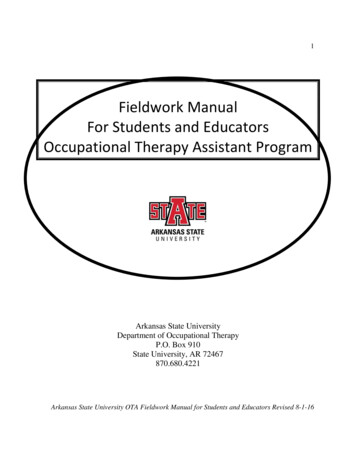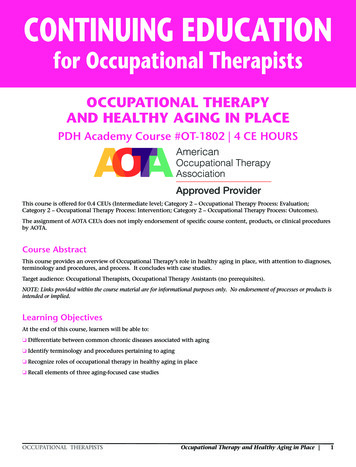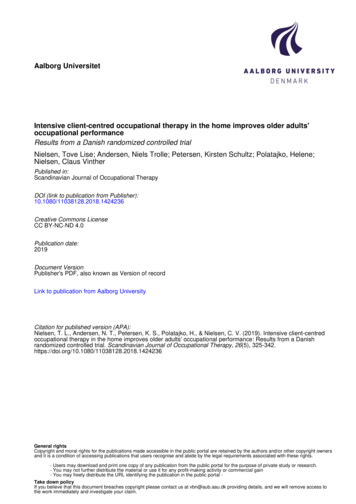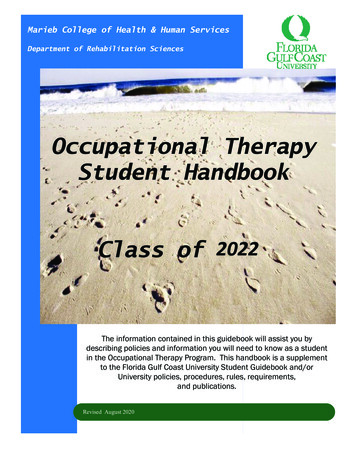
Transcription
Occupational therapyfor adults undergoingtotal hip replacementPractice guidelineCollege of Occupational TherapistsSpecialist SectionTraumaandOrthopaedics
Cover photographs(inset, top right) Tessa WoodfineMrs Jeffries, a service user, describes her experience of totalhip replacement:Total Hip Replacements may be a common procedure but they arealways life-changing and challenging for the individual concerned.As my osteoarthritis became more severe I was very concerned thatI would lose my independence and, in effect, become old beforemy time. The success of my surgery is demonstrated by my manyactivities: I drive, use public transport, swim, garden and play with mygrandchildren. Discussions with occupational therapists proved to be anessential part of the healing process not least because my own specificneeds and lifestyle were addressed. Practical aids in the bathroom andon a steep staircase meant I could safely manage alone and realisticadvice encouraged me to be bold without endangering myself. Thesurgical team began a process which with time, information andexercise has resulted in a busy and varied life with many choices andthe freedom to enjoy time with friends and family.All other images iStockphoto.comOther COT practice guidelines available:Occupational therapy clinical guidelines for rheumatology (2003)Occupational therapy for people with Parkinson’s (2010)Occupational therapists’ use of occupation-focused practice insecure hospitals (2012)Occupational therapy with people who have had lower limbamputations (2011)For further details, more publications and free downloads pleasevisit www.cot.org.uk/publicationsAbout the publisherThe College of Occupational Therapists is a wholly ownedsubsidiary of the British Association of Occupational Therapists(BAOT) and operates as a registered charity. It represents theprofession nationally and internationally, and contributes widelyto policy consultations throughout the UK. The College sets theprofessional and educational standards for occupational therapy,providing leadership, guidance and information relating to researchand development, education, practiceand lifelong learning. In addition,11 accredited specialist sections supportexpert clinical practice.www.COT.org.uk1/12
Occupational therapyfor adults undergoingtotal hip replacementPractice guidelineCollege of Occupational TherapistsSpecialist SectionTraumaandOrthopaedics
First published in 2012by the College of Occupational Therapists Ltd106–114 Borough High StreetLondon SE1 1LBwww.cot.org.ukCopyright College of Occupational Therapists 2012Author: College of Occupational TherapistsEditor: Mandy SaintyGuideline Development Group: Jade Cope, Christine Gibb, Sheila Harrison, Shirley McCourt,Lauren Porter, Kate RobertsonCategory: Practice GuidelineDate for Review: 2017All rights reserved, including translation. No part of this publication may be reproduced, storedin a retrieval system or transmitted, by any form or means, electronic, mechanical, photocopying,recording, scanning or otherwise without the prior permission in writing of the College ofOccupational Therapists, unless otherwise agreed or indicated. Copying is not permitted exceptfor personal and internal use, to the extent permitted by national copyright law, or under theterms of a licence issued by the relevant national reproduction rights organisation (such as theCopyrights Licensing Agency in the UK). Requests for permission for other kinds of copying, suchas copying for general distribution, for advertising or promotional purposes, for creating newcollective works, or for resale, should be addressed to the Publications Officer at the aboveaddress.Other enquires about this document should be addressed to the College of OccupationalTherapists Specialist Section – Trauma and Orthopaedics at the above address.British Library Cataloguing in Publication DataA catalogue record for this book is available from the British LibraryWhilst every effort has been made to ensure accuracy, the College of Occupational Therapistsshall not be liable for any loss or damage either directly or indirectly resulting from the use ofthis publication.ISBN 978-1-905944-39-2Typeset by Servis Filmsetting Ltd, Stockport, CheshireDigitally printed on demand in Great Britain by the Lavenham Press, Suffolk
ContentsForeword by Professor Avril Drummond Foreword by Mrs Sue Knowles vviKey recommendations for implementation 111.11.21.31.41.51.6Introduction National context: hip replacement statistics Context of service delivery The occupational therapy role Practice requirement for the guideline Topic identification process Conflicts of interest 55691212132Objective of the guideline 1433.13.23.3Guideline scope Clinical question Target population Target audience 1515161744.14.24.34.44.54.6Guideline development process The guideline development group Stakeholder involvement Service user involvement External peer review and consultation Declaration of funding for the guideline development College appraisal and ratification process 1919192021212255.15.25.35.45.55.6Guideline methodology Guideline question Literature search strategy and outcomes Criteria for inclusion and exclusion of evidence Strengths and limitations of body of evidence Methods used to arrive at recommendations Limitations and any potential bias of the guideline 2323232525282966.16.26.3Background to clinical condition Anatomy of the hip Osteoarthritis Total hip replacement 31313131College of Occupational Therapists iii
Contents77.17.27.37.47.57.67.7Guideline recommendations Maximised functional independence Reduced anxiety Resumption of roles Low readmission rates Decreased length of hospital stay Reduced demand on support services Reintegration into the community 333340454851545688.18.28.3Service user perspectives of the recommendations Overall service user opinions Understanding the recommendations Preparing for the operation and achieving benefits and outcomes after surgery 5858585999.19.29.3Implementation of the guideline Dissemination and promotion Organisational and financial barriers Implementation resources 6161616210Recommendations for future research 6411Updating the guideline 66Appendix 1: Guideline development group 67Appendix 2: Acknowledgements 68Appendix 3: Service user consultation 70Appendix 4: Literature search strategy 74Appendix 5: Evidence- based review tables 78Appendix 6: Glossary and abbreviations 105References 107Note: The term ‘service user’ is used within this document to refer to adults undergoing atotal hip replacement.This guideline was developed using the processes defined within the Practiceguidelines development manual (College of Occupational Therapists [COT] 2011a).Readers are referred to the manual to obtain further details of specific stages withinthe guideline development process.The manual is available at: ublic/PracticeGuidelinesDevMan.pdf ivOccupational therapy for adults undergoing total hip replacement
ForewordI am delighted to have been asked to write the foreword for Occupational therapy foradults undergoing total hip replacement. This guideline is the work of occupationaltherapists who have had the vision, enthusiasm and perseverance to address this longoverdue area; we now have a benchmark of what we should be doing as well asflagging up what we should be improving.Total hip replacement is a common procedure with statistics continuing to show largenumbers of operations being conducted and, indeed, steadily increasing. From 2010–11,over 77,800 primary hip replacements and 9,000 revisions were carried out in Englandand Wales (National Joint Registry 2011, p35). Yet although the role of occupationaltherapy is well established and recognised (British Orthopaedic Association 2006), thereare rapid changes in the face of practice – not only in the timings of interventions but inthe age and range of people needing rehabilitation. Occupational therapists aretreating more people of working age who have had hip replacements as well ascontinuing to treat their more traditional caseload of older patients. They seem to beseeing people earlier, and patients are being discharged more quickly because of thecurrent emphasis on shortening hospital stay and the implementation of ‘rapidrecovery’ initiatives.Such changes on the coalface are reflected in the widespread variation that exists innational practice. Such variations reflect differences in surgical opinion, in serviceconfigurations and the dearth of robust research evidence to underpin clinical practice.This lack of research extends from addressing the most fundamental questions on theuse of hip precautions to the best ways of delivering pre- operative and post- operativeeducation and care within a service. Consequently, although this guideline tacklespractical issues by examining the literature and making recommendations to guideclinicians, it also highlights the gaps in the evidence. There are key occupational therapyquestions to be answered and therapists must rise to this challenge.Professor Avril Drummond PhD, MSc, FCOTProfessor of Healthcare Research and Occupational TherapistUniversity of NottinghamCollege of Occupational Therapists v
ForewordFollowing my involvement in the service user consultation for this practice guideline foroccupational therapists working with adults undergoing total hip replacement, it is apleasure to be asked to provide a foreword.Throughout the development of this guideline service users have been consulted in ameaningful and effective manner, being offered opportunities to share our experiencesof undergoing total hip replacement, and we have appreciated clinical staff listening toour views and experiences.The guideline provides an excellent resource for occupational therapists in theassessment and treatment of people undergoing total hip replacement surgery. Itensures the occupational therapist has the opportunity to gain knowledge of the wholeperson and that they take into account issues for carers and the service user’s mentalwellbeing. This, in turn, will benefit the service user by ensuring their care is focused ontheir recovery and resumption of roles, tailored to their individual needs, and mostimportantly that they are offered consistent and evidence- based advice andinterventions.Mrs Sue KnowlesChair, Rushcliffe 50 Forum Health Sub GroupNottinghamshire viOccupational therapy for adults undergoing total hip replacement
Key recommendations forimplementationThe aim of this practice guideline is to provide specific recommendations that describethe most appropriate care or action to be taken by occupational therapists workingwith adults undergoing total hip replacement. The recommendations are intended tobe used alongside the therapist’s clinical expertise and, as such, the clinician is ultimatelyresponsible for the interpretation of this evidence- based guideline in the context oftheir specific circumstances and service users.The recommendations should not be taken in isolation and must be considered inconjunction with the contextual information provided in this document and with thedetails on the strength and quality of the recommendations. It is strongly advised thatreaders study section 5 together with the evidence tables in Appendix 5 to understandthe guideline methodology and to be fully aware of the outcome of the literaturesearch and overall available evidence.Recommendations are scored according to strength, 1 (strong) or 2 (conditional), andgraded from A (high) to D (very low) to indicate the quality of the evidence. The sevenrecommendation categories reflect the potential outcomes for service users followingtotal hip replacement and occupational therapy intervention, and are presented in theorder of prioritisation identified from service user consultation.Maximised functional independence1. I t is recommended that the occupational therapy assessment iscomprehensive and considers factors which may affectindividual needs, goals, recovery and rehabilitation, including co‑morbidities, trauma history, personal circumstances, obesity and pre‑operative function.1C (Johansson et al 2010, C; Lin and Kaplan 2004, C; Marks 2008, C; Naylor etal 2008, C; Ostendorf et al 2004, C; Vincent et al 2007, C; Wang et al 2010,C)2. I t is recommended that goal setting is individualised, enhances realisticexpectations of functional independence, and commences at pre- operativeassessment.1C(Judge et al 2011, C; Mancuso et al 2003, C)3. I t is recommended that occupational therapists ensure that they provideclear communication and advice that is consistent with that of othermembers of the multidisciplinary team.1C(Fielden et al 2003, C)College of Occupational Therapists 1
Key recommendations for implementation4. I t is recommended that depression and anxiety status are taken intoaccount during pre- operative and post- operative intervention due to theirpotential for impact on recovery.(Caracciolo and Giaqunito 2005, C; Nickinson et al 2009, C)1C5. I t is recommended that cognitive status is taken into account during pre- operative and post- operative intervention due to its potential for impacton recovery.1C(Wang and Emery 2002, C; Wong et al 2002, C)6. I t is recommended that service users are fully involved in decisions aboutthe equipment required to enable them to carry out daily living activitiesand to comply with any hip precautions in their home environment post- surgery.1D(Thomas et al 2010, D)7. I t is recommended that service users are given advice on effective painmanagement strategies, to decrease pre- operative pain experience andsleep disturbance, and enhance post- operative physical function.1B(Berge et al 2004, B; Montin et al 2007, C; Parsons et al 2009, C)8. It is suggested that standardised assessment and outcome measures are used,where appropriate, to determine functional outcome and occupationalperformance in rehabilitation settings, either inpatient or community based.2C(Gillen et al 2007, C; Kiefer and Emery 2004, C; Oberg et al 2005, D)Reduced anxiety9. I t is recommended that the pre- operative assessment undertaken by theoccupational therapist allows adequate time for individualised questionsand discussion of expectations and anxieties.(Fielden et al 2003, C; McDonald et al 2004, A; Montin et al 2007, C)1A10. I t is suggested that occupational therapists offer support and advice toservice users who may be anxious about an accelerated discharge home.2C(Heine et al 2004, D; Hunt et al 2009, D; Montin et al 2007, C)11. I t is recommended that pre- operative assessment and education iscarried out in the most appropriate environment for the service user. Forthe majority of service users a clinic environment is appropriate, butwhere needs are complex, a home assessment should be an availableoption.1B (Crowe and Henderson 2003, B; Drummond et al 2012, C; Orpen and Harris2010, C; Rivard et al 2003, B)12. I t is suggested that provision of equipment pre- operatively may facilitatefamiliarity and confidence in use.2C(Fielden et al 2003, C; Orpen and Harris 2010, C) 2Occupational therapy for adults undergoing total hip replacement
Key recommendations for implementation13. I t is suggested that service users may value being treated by the sameoccupational therapist throughout the process, from pre- operativeassessment/education to post- operative rehabilitation wherever possible.2C(Spalding 2003, C)14. I t is suggested that occupational therapists should contribute tostandardised pre- operative education interventions, providinginformation, advice and demonstrations where relevant (e.g. of jointprotection principles, equipment).2B (Coudeyre et al 2007, B; Johansson et al 2007, B; Spalding 2003, C;Spalding 2004, C; Soever et al 2010, C)Resumption of roles15. I t is recommended that work roles are discussed at the earliest opportunityas part of a comprehensive assessment.1C(Bohm 2010, C; Mobasheri et al 2006, D; Nunley et al 2011, C)16. I t is suggested that for service users who are working, advice is providedrelating to maintaining their work role pre- operatively, post- operativeexpectations and relevant information for employers.2C (Bohm 2010, C; Mobasheri et al 2006, D; Nunley et al 2011, C; Parsons et al2009, D)17. I t is recommended that occupational therapists provide advice to facilitateservice users to establish previous and new roles and relationships, andshift their focus from disability to ability.1C(Grant et al 2009, C)Low readmission rates18. I t is recommended that occupational therapists consult with the surgicalteam regarding any specific precautions to be followed post- operatively.1B (Hol et al 2010, B; Peak et al 2005, B; Restrepo et al 2011, B; Stewart andMcMillan 2011, C; Ververeli et al 2009, B)19. I t is recommended that occupational therapists advise service users, whereprotocol includes precautions, on appropriate position behaviours forthose daily activities applicable to the individual’s needs, ranging fromgetting in/out of a car to answering the telephone.1B (Drummond et al 2012, C; Malik et al 2002, D; Peak et al 2005, B; Stewartand McMillan 2011, C; Ververeli et al 2009, B)20. I t is suggested that due to the uncertainty surrounding the need for hipprecautions, and the potential for an increase in satisfaction and earlyfunctional independence when hip precautions are relaxed ordiscontinued, occupational therapists engage in local discussion/review ofthe emerging evidence with their surgical and multidisciplinary teams.2B (Drummond et al 2012, C; O’Donnell et al 2006, D; Peak et al 2005, B;Restrepo et al 2011, B; Ververeli et al 2009, B)College of Occupational Therapists 3
Key recommendations for implementationDecreased length of hospital stay21. It is recommended that occupational therapists optimise length of stay, withdue reference to care pathways and enhanced recovery programme guidance.1B (Berend et al 2004, C; Bottros et al 2010, C; Brunenberg et al 2005, C;Husted et al 2008, C; Kim et al 2003, B)22. I t is recommended that the occupational therapist is involved in earlymultidisciplinary post- operative intervention for service users following hipreplacement, providing either inpatient or home- based rehabilitation.1A(Iyengar et al 2007, C; Khan et al 2008, A; Siggeirsdottir et al 2005, C)Reduced demand on support services23. I t is suggested that there are potential benefits in including informal carersin pre- operative assessment/education, and post- operative intervention, tomaximise service user independence and reduce carer stress.2C(Chow 2001, C)Reintegration into the community24. I t is recommended that occupational therapists encourage early discussionand goal setting for community reintegration, including social and physicalactivities.1C(de Groot et al 2008, D; Gillen et al 2007, C)25. I t is suggested that where specific needs are identified, the occupationaltherapist refers the service user on to community rehabilitation,reablement or intermediate care services to enhance communityreintegration.2C(de Groot et al 2008, D; Gillen et al 2007, C) 4Occupational therapy for adults undergoing total hip replacement
1IntroductionTotal hip replacement has been identified as an effective treatment for the hip jointthat causes pain and is no longer functioning properly, and when conservativemanagement is no longer effective. Indications for a primary total hip replacement arepain and disability arising from osteoarthritis or inflammatory arthritis in the hip joint(British Orthopaedic Association [BOA] 2006, p5).The National Institute for Health and Clinical Excellence [NICE] Clinical Guideline for thecare and management of adults with osteoarthritis states:Referral for joint replacement surgery should be considered for people withosteoarthritis who experience joint symptoms (pain, stiffness and reduced function) thathave a substantial impact on their quality of life and are refractory to non- surgicaltreatment. Referral should be made before there is prolonged and establishedfunctional limitation and severe pain. (NICE 2008, p14)Outcomes include improved symptoms and functional status with continuation inimprovement for the first year after the operation (The Royal College of Surgeons ofEngland and the BOA 2000, p8).Hip replacement may also be indicated following trauma to the hip, such as in hipfracture, being particularly relevant for adults with pre- existing joint disease, medium/high activity levels, and who are not cognitively impaired (NICE 2011, ScottishIntercollegiate Guidelines Network [SIGN] 2009).This practice guideline focuses on total hip replacement. It is recognised that some of therecommendations will be directly applicable to elective surgery only, rather than traumasurgery. However, the majority of the recommendations will be appropriate to serviceusers undergoing a total hip replacement whatever the pre- disposing circumstances.Occupational therapy staff involved in treating service users post hip fracture should,however, also refer to national hip fracture guidelines (SIGN 2009, NICE 2011) andquality standards (NICE 2012), together with national falls guidelines (NICE 2004) andprofessional guidance on falls management (COT 2006).1.1 National context: hip replacement statisticsInformation on hip replacement procedures in the United Kingdom (UK) is recorded;however, the data are not available as a single source.The National Joint Registry holds details on joint replacement surgery for England andWales, and includes procedures undertaken by both the National Health Service and theindependent healthcare sector. In Scotland, the Scottish Arthroplasty Project usesScottish Morbidity Records sent by hospitals to the Information Services Division toascertain the number and outcome of joint replacements undertaken. Comprehensivestatistics for the whole of Northern Ireland could not be sourced, but details for theBelfast Health and Social Care Trust and Southern Health and Social Care Trust providesome indication of procedures completed (Table 1).College of Occupational Therapists 5
IntroductionTable 1: UK primary hip joint procedure statisticsEngland andWalesScotlandNorthern IrelandPrimary hip jointprocedures 0/11Average age67.26867.467.95Percentage female59%60%54%56%Percentage HS NationalServicesScotland(2010)BelfastHealth andSocial CareTrust (2011)SouthernHealth andSocial CareTrust (2011)The numbers of primary hip joint replacements completed has been increasing. InEngland and Wales for example, an additional 19,335 procedures were carried out in2010/11 compared to 2006/07. Scotland has also seen an increase, with an additional1,259 procedures undertaken in 2009 compared to 2005.The surgical intervention statistics demonstrate that there is a high volume of serviceusers in the UK undergoing primary total hip replacement, with these numberscontinuing to rise in England, Wales and Scotland on an annual basis.1.2 Context of service deliveryThe Musculoskeletal Services Framework (Department of Health [DH] 2006), which isendorsed by the College of Occupational Therapists, focuses on best practice guidanceto support people with musculoskeletal conditions, whether a result of disease, injury ordevelopment disorder. It is intended to assist in the delivery of improved access forservice users, and in the reduction of waiting times for treatment. While directlyapplicable to England, the vision is one which can be universally shared by alloccupational therapists working in this field of practice:The vision is that people with musculoskeletal conditions can access high- quality,effective and timely advice, assessment, diagnosis and treatment to enable themto fulfil their optimum health potential and remain independent. (DH 2006, p6)The framework includes a pathway for adults with hip pain, demonstrating the serviceuser flow from pain onset to surgery (Figure 1). Multidisciplinary working and ‘sharedcare’ are seen as being fundamental to the approach, together with integrated carepathways based on the entire journey taken by a service user.The framework identifies the involvement of occupational therapists early in thepathway, a requirement previously highlighted in the report Hip replacements: Anupdate published by the National Audit Office (NAO 2003). Occupational therapistsshould be involved in active management within the community; at themusculoskeletal interface clinic; in multi- professional pre- operative assessment with 6Occupational therapy for adults undergoing total hip replacement
Healtheducation ofpublic/informationPromote selfmanagementPatientchoice ondecisionto consult24GPActive management1Musculoskeletalinterface clinicsExtended-scopephysiotherapistsGPwSlsNurse practitionersprovide trainingopportunity for SPRsFunction andeducation ent of patientto be listed forsurgery, interface withpodiatry/occupationaltherapyPatient informationFacilitate selfmanagement3Give patientinformationFeedback from specialist1Direct listing of routine casesunder locally agreed protocol and consentSelf-referralphysiotherapyas first lineInterface withother primarycare services,e.g. podiatry,occupational therapy6Outcomet measureCollege of Occupational TherapistsPatient choiceAcute unit orcommunityAgreed booking(see Chooseand book)OrthopaedicconsultantList am ingassessmentFitness for surgery andeducationBookedadmission anddischargeIdentification ofdischarge needsNurse-led8Figure 1 Hip and knee pain patient flow from pain onset to surgery for adult elective patients(DH 2006 p9 Reproduced under the Open Government Licence v1.0. Available at: ment-licence) 7IntroductionInpatient and outpatient follow-upShared between physiotherapist/nurse/consultantteam as locally agreed
Introductionidentification of potential post- operative service user concerns; in the provision ofadaptive equipment and in discharge planning to prevent discharge delays followingsurgery.The importance of an agreed process for continued rehabilitation where indicated isalso identified as part of the flow process. It is therefore important that total hipreplacement elective surgery and the guideline recommendations within thispublication are seen in the context of a wider clinical pathway.The involvement of occupational therapists, particularly in pre- admission assessment, isalso highlighted in the consensus document, Primary total hip replacement: a guide togood practice, published by the British Orthopaedic Association (BOA 2006). It states thatthe involvement of occupational therapists, along with other members of themultidisciplinary team, can assist in preventing cancellation of surgery, allow co- morbidities and risk factors to be identified, and facilitate discharge planning. The homecircumstances and availability of carers after discharge from hospital are also identifiedas being important (BOA 2006 p8 5.6). Pre- admission assessment provides an opportunityfor service user education and establishing expectations, particularly with regard to therisk and benefits of the operation and the discussion of goals (BOA 2006 p8 5.2).The period between admission and discharge for routine elective surgery has reduced inrecent years, with a median length of stay recorded as 5 days for total hip replacement inEngland during 2009/2010 (Health Service Journal 2011). In Scotland the average lengthof stay in 2009 was reported as 6.2 days, with 35 per cent of service users being admittedon the day of surgery (NHS National Services Scotland 2010). Length of stay is associatedwith cost, and there is an expectation that clinical pathways in addition to promotingbest practice will reduce length of stay and shorten post- operative rehabilitation.Sourcing information on an indicative cost of elective hip replacement interventionacross the UK is not simple. It is complicated by the different funding and paymentstructures within each country, and the variables in the nature of service delivery. Toprovide a proxy indicator of the cost of a total hip replacement for this guideline, theDepartment of Health Payment by results guidance for 2011–12 for England (where themajority of hip replacements are undertaken) has therefore been used (DH 2011, p60).This defines a primary total hip replacement best practice tariff of 5,227 where nocomplications or co- morbidities exist (the figure is increased to 5,365 wherecomplications and co- morbidities are identified).Best practice tariffs have been applied to elective total hip replacements in Englandfrom 2011– 12, demonstrating how clinical pathways can be potentially linked with cost.Best practice tariffs target interventions with high impact, and a strong evidence baseor clinical consensus of best practice characteristics. They aim to encourage high qualityand cost effective care. This includes good clinical management and reduced lengths ofstay. This is identified in the payment by results guidance for hip replacements asincluding four key aspects:a) Pre- operative assessment, planning and preparation before admission.b) A structured approach to peri- operative and immediate post- operativemanagement, including pain relief.c)Early supervised mobilisation and safe discharge.d) Structured plans for access to clinical advice and support in the periodimmediately after discharge, including outreach rehabilitation. (DH 2011, p59) 8Occupational therapy for adults undergoing total hip replacement
IntroductionIn terms of best practice approaches to intervention, ‘enhanced recovery’ (or rap
7.7 Reintegration into the community 56 8 Service user perspectives of the recommendations 58 8.1 Overall service user opinions 58 8.2 Understanding the recommendations 58 8.3 Preparing for the operation and achieving benefits and outcomes after surgery 59 9 Implementation of the guideline 61 9.1 Dissemination and promotion 61











